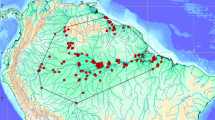Abstract
The chemical activators of feeding behaviour for coelenterates have been generally regarded as species specific. Recently, however, and English (North Sea) population of the sea anemone Diadumene (Haliplanella) luciae (Verrill) and an American (Californian) population of the same species were found to respond to different chemical activators. The results of further examination of this apparent anomaly show that a third population (from the English Channel, selected because of differences in colour variety and type of habitat from the North Sea population) shared the same activators as the other English population. There was no correlation between the identities of the feeding-behaviour activators and either the type of habitat or coloration of the three populations. Since the only physical factor shared by anemones with similar activators (i.e., the two English populations) was geographical, it is tentatively concluded that physiological races of D. luciae may be evolving, independently of morphological or differently coloured races, in different parts of the world.
Similar content being viewed by others
Literature Cited
Hand, C.: The sea anemones of Central California—III. The acontiarian anemones. Wasmann J. Biol. 13, 189–251 (1955).
Lenhoff, H. M.: Mechanical stimulation of feeding in Epiactis prolifera. Nature, Lond. 207, p. 1003 (1965).
Lindstedt, K. J.: Chemical control of feeding behaviour. Comp. Biochem. Physiol. 39A, 553–581 (1971).
Marine Biological Association: Plymouth marine fauna, 459 pp. 3rd ed. Plymouth: Latimer, Trend & Co. Ltd. 1957.
Stauber, L. A.: The problem of physiological species with special reference to oysters and oyster drills. Ecology 31, 109–118 (1950).
Stephenson, T. A.: The British sea anemones, Vol. II. 426 pp, London: The Ray Society 1935.
Uchida, T.: Occurrence in Japan of Diadumene luciae, a remarkable actinian of rapid dispersal. J. Fac. Sci. Hokkaido Univ. (Ser. 6) 2, 69–82 (1932).
—: Influence of the currents upon the distribution of races and frequency of asexual reproduction in the actinian, Diadumene luciae. Zool. Mag., Tokyo 48, 895–906 (1936).
Weil, C. S.: Tables for convenient calculation of median-effective dose and instructions in their use. Biometrics 8, 249–263 (1952).
Williams, R. B.: Chemical control of feeding behaviour in the sea anemone Diadumene luciae (Verrill). Comp. Biochem. Physiol. 41A, 361–371 (1972a).
—: Notes on the history and invertebrate fauna of a poikilohaline lagoon in Norfolk. J. mar. biol. Ass. U.K. 52, 945–963 (1972b).
Author information
Authors and Affiliations
Additional information
Communicated by J. H. S. Blaxter, Oban
Rights and permissions
About this article
Cite this article
Williams, R.B. Are there physiological races of the sea anemone Diadumene luciae?. Mar. Biol. 21, 327–330 (1973). https://doi.org/10.1007/BF00381089
Accepted:
Issue Date:
DOI: https://doi.org/10.1007/BF00381089




